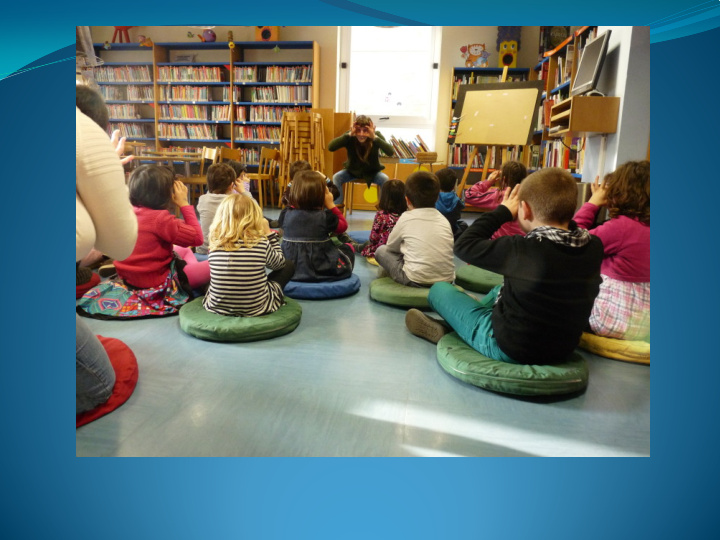



Presenter: Nguyen Thi Phuong Thao
Context of Teaching and Learning English Teaching English • English to young learners • 2020 National textbooks Project of FLs • Methodology modification innovation Storytelling is embedded in Goal and aim textbooks
The practice of teaching and learning English as a foreign language EFL teaching in Vietnam focuses too much on linguistic forms (Nguyen, 2011; Le & Do, 2012) but too little on meaning-making process.
Objectives of storytelling in EFL Developing semantic Engaging learning learning and with stories and comprehension storytelling promoting language learning, possibly beyond language learning
Using stories and storytelling in second and foreign language education Recent studies reveal the pedagogical application of stories and storytelling to English language teaching and learning. (Bundy, Piazzoli, & Dunn, 2015; Colon- Vila, 1997; Fitzgibbon & Wilhelm, 1998; Hendrickson, 1992; Mokhtar, Halim, & Kamarulzaman, 2011; Uchiyama, 2011)
“Stories should be a central part of the work of all primary teachers whether they are teaching the mother tongue or a foreign language” (A. Wright, 1995, p. 4) Stories and storytelling provide not only content of language but also a means to convey the content to learners .
Talk is “one of the most fundamental things that goes on in classrooms” (p. 23) Talk “puts interaction and dialogue at the heart of the learning process because they construct resources for thinking” (Gibbons, 2015, p. 32) Storytelling as classroom talk Storytelling as pedagogy Offers children an access to comprehensible input with multimodality as scaffolding for comprehensible output (Swain, 2000)
Storytelling design Multimodality: interaction Stories and between Oral language storytelling storytelling and comprehension learning process in classroom,
Storytelling design posture, gesture (i.e., iconic, spoken language metaphoric, deictic, and beat) Multimodal frame (Block, 2014) body movements, visual images facial expressions, and gaze
• Story selection Storytelling • Purposes session • oral language Follow-up comprehension • make meaning of activities the story
Storytelling design Select short oral stories of some genres (e.g. fables, fairy tales, or myths from around the word). The stories are created in an imaginative world, which “bear enough resemblance to children and their real worlds” (Cameron, 2001, p. 166) to ensure that children have background to learn the new things. Plot of the story is new to learners to engage their listening and encourage language discovery.
The language use in the stories was rich but contextualised in a predictable pattern. The choice of target words in stories was based on part of speech and frequency. Each story was selected with a sequence of events and a central factor of interest according to structure. The purpose was to construct children’s sense of people, animals, and objects in themes and sense of time (e.g. the past, the present and the future).
Follow-up class activities Story-based activities designed to reinforce children’s language comprehension and reveal their awareness of what they could learn from the stories These activities were not particularly designed to teach the language in the story
Conclusion Storytelling: an art for making sense of the language and a good source of oral language exposure for language intake and comprehension. Different from more instructional methods of EFL, storytelling offers a means for meaning discovery. Stories provide “a method of thinking, of sharing experience and of assigning meaning” (S. Wright, 2012, p. 18) and “for young children, talking is the way they organise their thoughts and make sense of the world about them” (Harrett, 2004, p. 5).
References Bundy, P., Piazzoli, E., & Dunn, J. (2015). Sociocultural theory, process drama and second language learning. In S. Davis, H. G. Clemson, B. Ferholt, S.-M. Jansson & A. Marjanovic-Shane (Eds.), Dramatic interactions in education: Vygotskian and sociocultural approaches to drama, education and research (pp. 153-170). New York;London;: Bloomsbury Academic. Colon-Vila, L. (1997). Storytelling in an ESL classroom. Teaching Pre K - 8 [H.W.Wilson - EDUC], 27 , 58. Cameron, L. (2001). Teaching Languages to Young Learners : Cambridge University Press. Fitzgibbon, H. B., & Wilhelm, K. H. (1998). Storytelling in ESL/EFL classrooms. TESL Reporter, 31 (2), 21-31. Retrieved from http://search.proquest.com/docview/85665127?accountid=14723 Gibbons, P. (2015). Scaffolding language, scaffolding learning: teaching English language learners in the mainstream classroom (Vol. Second). Portsmouth, NH: Heinemann.
Harrett, J. (2004). Tell me another...Speaking, listening, and learning through storytelling United Kingdom Literacy Association. Hendrickson, J. M. (1992). Storytelling for Foreign Language Learners (pp. 25). Le, V. C., & Do, T. M. C. (2012). Primary school English-language education in Asia: from policy to practice. In B. Spolsky & Y.-i. Moon (Eds.), (Vol. 1., pp. 106-128). New York, NY: Routledge. Mokhtar, N. H., Halim, M. F. A., & Kamarulzaman, S. Z. S. (2011). The Effectiveness of Storytelling in Enhancing Communicative Skills. Procedia - Social and Behavioral Sciences, 18 (0), 163-169. doi: http://dx.doi.org/10.1016/j.sbspro.2011.05.024 Nguyen, T. M. H. (2011). Primary English language education policy in Vietnam: insights from implementation. Current Issues in Language Planning, 12 (2), 225-249. doi: 10.1080/14664208.2011.597048
Swain, M. (2000). The output hypothesis and beyond: Mediating acquisition through collaborative dialogue. In J. P. Lantolf (Ed.), Sociocultural theory and second language learning (pp. 97-114). New York; Oxford [Eng]: Oxford University Press. Uchiyama, T. (2011). Reading versus telling of stories in the development of English vocabulary and comprehension in young second language learners. Reading Improvement, 48 (4), 168-178. Wright, A. (1995). Storytelling with children . Oxford: Oxford University Press. Wright, S. (2012). Children, meaning-making and the arts (Vol. 2nd). Frenchs Forest, N.S.W: Pearson Australia.
Recommend
More recommend